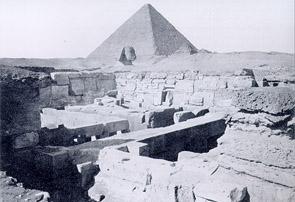|
Giza
Sphinx in Pictures
PAGE 4
|
The
erosion of the southern and western walls of the Sphinx enclosure
is clear at bottom left: in the corner between the two walls
there is the notch created where the enclosure cuts into the
ditch alongside the Khafre causeway (which runs up to the Khafre
pyramid from bottom left at the top of the enclosure wall);
the presence of this notch, filled with pieces of granite, indicated
to Professor Selim that the enclosure had been cut after the
ditch of the causeway and that the notch had had to be plugged
to prevent rainwater from running into the enclosure and round
the lower body of the Sphinx.
But what did the Sphinx look like when it was first made, and
the years had not yet taken their toll of erosion and damage
- with the beard (and its support plate) in place, with the
uraeus cobra intact on its brow, with the head-dress gathered
together in a queue on the back of the body, with the lappets
of the head-dress descending over the shoulders, but without
perhaps any statue yet before its breast and without the Dream
Stela in its little chapel between the paws? How much was originally
built on to the living rock with additional masonry blocks,
or perhaps added in plaster, we cannot say.

The
Sphinx seen over the valley temple of Khafre, by sebah |
The two foremost scholars of the Sphinx in our day have disagreed
about that: Dr Zahi Hawass has suggested that most if not
all of the body was clad from the first; Dr Mark Lehner thinks
it was mostly carved from the living rock to begin with and
only required cladding after hundreds of years of neglect
and erosion. Our reconstruction shows few details of masonry,
therefore, without implying that none at all was present at
the start, is not a good deal.
|
 |
The
Sphinx temple in front of (and below the level of) the monument
itself may never have seen much use to judge by its not quite
finished state, and so it is possible that the Sphinx, too,
was never completed and was neglected within a short time.
Some three hundred years after Khafre's death, during the
time of social collapse that Egyptologists call the First
Intermediate Period, the signs are that his valley temple
was ransacked and his statues there deliberately smashed -
it is unlikely that the Sphinx would have escaped the attentions
of the wreckers at the same time, when the monuments of Giza
were attacked in general. The beard would have been an easy
target and the vandals may well have forced off some of any
cladding blocks that were part of the original design.

The
Sphinx by Lekegian, showing the scale of the head against
a standing human figure and the characteristic erosion
of the Sphinx body. Note the fissure at the haunches,
before it was part-filled with cement. |
Egyptologists believe that it is from this time, in about
2200 BC, that the decline of the monument dates. The sands
would have quickly swamped the neglected Sphinx, and under
them the process of erosion would have got to work on the
lion's body, while the desert winds scoured the neck and picked
out the weak lines in the human head and face. So that by
the time of Tuthmosis IV, the Sphinx was ripe for restoration,
as it has been on at least three occasions since.
Such, at least, is the view of the Egyptologists about the
creation and decay of the Great Sphinx, its restoration and
subsequent further decline. But there are other interpretations
of the Sphinx's history and vicissitudes and they continue
to be developed and aired by their proponents.
|